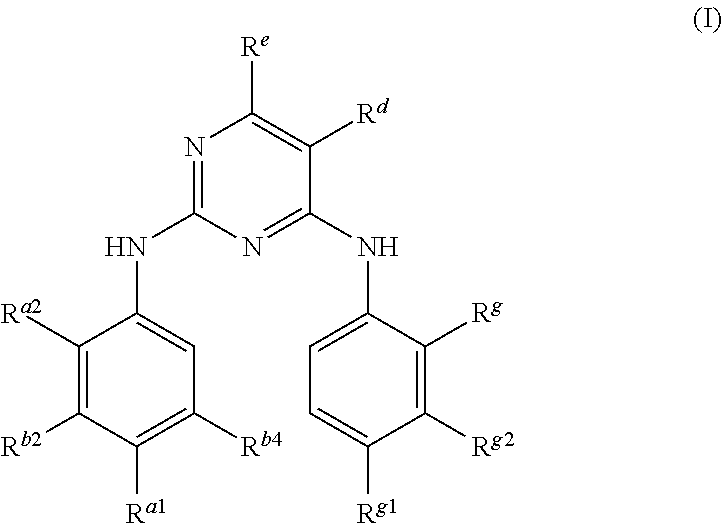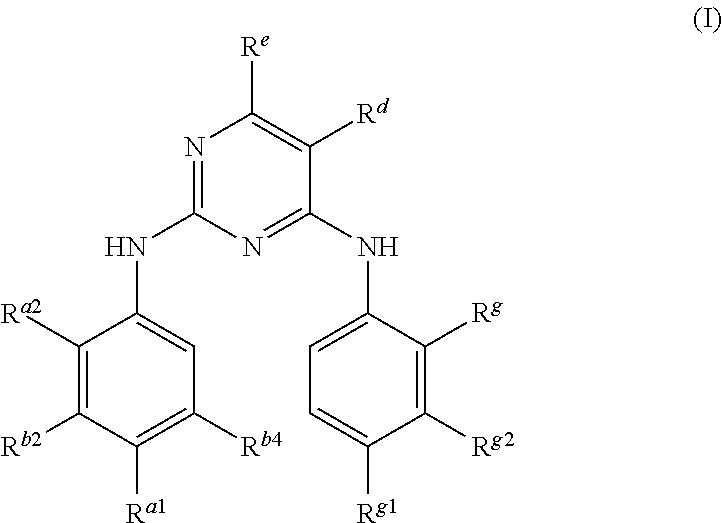Methods for Inhibiting Cell Proliferation in EGFR-Driven Cancers
a technology of egfr-driven cancer and cell proliferation inhibition, which is applied in the direction of biocide, group 5/15 element organic compounds, drug compositions, etc., can solve the problems of limited clinical efficacy of gefitinib and erlotinib, and the inability to effectively inhibit cell proliferation, so as to reduce the risk and be easily measured
- Summary
- Abstract
- Description
- Claims
- Application Information
AI Technical Summary
Benefits of technology
Problems solved by technology
Method used
Image
Examples
example 1
Kinase Assays
[0111]Assays were conducted for an in vitro kinase panel having WT EGFR, L858R, T790M, and L858R / T790M. Additional assays can be conducted with the panel further including delE746_A750 and delE746_A750 / T790M. Assay conditions included 10 pt curves with 3 μM top concentration (singlicates) and 10 μM ATP.
[0112]Compounds formula (I) included potent inhibitors of EGFR mutants in kinase assays. For example, in the H1975 cell line having L858R and T790M mutations, previously known inhibitors gefitinib, CL-387,785, and HKI-272 had IC50 values between 153 nM to >3.3 μM, while many compounds of formula (I) exhibited IC50 values in the range of 0.5 to 9 nM. Thus, compounds of formula (I) could provide the necessary inhibitors for EGFR-driven cancers.
example 2
Cellular and In Vivo Assays
[0113]NSCLC cell lines as well as engineered Ba / F3 and NIH3T3 cell lines were used to examine the activity of compounds of formula (I) against 3 general forms of EGFR: native EGFR (the naturally occurring form), EGFR with an activating mutation (delE746_A750 [Del] or L858R; this form is sensitive to first generation EGFR inhibitors), and EGFR with both an activating mutation and a T790M resistance mutation (L858R / T790M or Del / T790M; the addition of the T790M mutation makes this form resistant to first generation EGFR inhibitors). Effects of test compounds on EGFR signaling were assessed by measuring levels of phosphorylated EGFR, effects on in vitro proliferation measured by a growth or viability assay, and effects on in vivo tumor growth measured in mice following daily oral dosing.
[0114]Test compounds of greatest interest were essentially inactive against native EGFR in cellular assays, i.e., inhibited phosphorylation with IC50s>1000 nM in a NSCLC cell l...
example 3
Cellular Inhibition Assays
[0118]Lung cancer cell lines were analyzed by determining phosphorylation and expression levels of various proteins. An immunoblot analysis of phosphorylation and expression levels of EGFR and other proteins in lung cancer cells was performed for lung cancer cell lines having different EGFR mutants. H358 expresses WT EGFR, HCC827 has a delE746_A750 mutation, H820 has delE746_E749 / T790M mutations, and H1975 has L858R / T790M mutations.
[0119]Immunoblot analyses were conduct for various compounds, including erlotinib, gefitinib, BIBW 2992, WZ4003, and several compounds of formula (I).
[0120]The immunoblot show that test compounds of formula (I) are potent inhibition of cancer cell lines having EGFR mutations. In particular, these compounds were efficacious against mutations generally associated with drug resistance, such as T790M and the combination of L858R and T790M.
PUM
| Property | Measurement | Unit |
|---|---|---|
| temperature | aaaaa | aaaaa |
| Rh | aaaaa | aaaaa |
| resistance | aaaaa | aaaaa |
Abstract
Description
Claims
Application Information
 Login to View More
Login to View More - R&D
- Intellectual Property
- Life Sciences
- Materials
- Tech Scout
- Unparalleled Data Quality
- Higher Quality Content
- 60% Fewer Hallucinations
Browse by: Latest US Patents, China's latest patents, Technical Efficacy Thesaurus, Application Domain, Technology Topic, Popular Technical Reports.
© 2025 PatSnap. All rights reserved.Legal|Privacy policy|Modern Slavery Act Transparency Statement|Sitemap|About US| Contact US: help@patsnap.com



